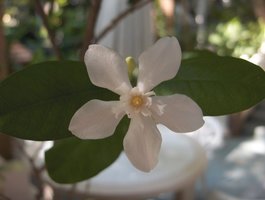Apocynaceae
|
|
| Dogbane family | ||||||||||
|---|---|---|---|---|---|---|---|---|---|---|
| Missing image Alyxia.oliviformis1web.jpg Alyxia oliviformis Alyxia oliviformis | ||||||||||
| Scientific classification | ||||||||||
| ||||||||||
| Genera | ||||||||||
The Family Apocynaceae or dogbane family of flowering plants includes trees, shrubs, herbs, or lianas. Many species are tall trees found in the tropical rainforest, and most are from the tropics and subtropics--but some come from Tropical dry, xeric environments. There are also some perennial herbs from temperate zones. Many of these plants have milky sap; and many species are poisonous if ingested. As to some genera of Apocynaceae, some as Adenium however, have both clear and wilky, latex sap; whereas Pachypodium always have clear sap.
| Contents |
Taxonomy
The family, as currently recognized, includes some 1500 species divided in about 424 genera. The family Asclepiadaceae is now, according to AGP II included in the Apocynaceae (Endress & Bruyn, 2000). However, the family Asclepiadaceae retains the epithet 'nom. cons.' (= name to be retained).
There are five subfamilies:
- Rauvolfioideae
- Apocynoideae
- Periplocoideae
- Secamonoideae
- Asclepiadoideae
The last three subfamilies used to belong to the Asclepiadaceae.
Distribution
Species in this family are distributed mainly in tropical regions:
- In the rainforests and swamps of India and Malaya: small to very tall evergreen trees, often with buttress roots, such as Alstonia and Dyer.
- In northern Australia: small evergreen trees such as Cerbera and Ochrosia.
- In deciduous forests of Africa and India: smaller trees such as Carissa, Wrightia and Holarrhena.
- In tropical America, India, Myanmar and Malaya: evergreen trees and shrubs, such as Rauwolfia, Tabernaemontana and Acokanthera.
- In Central America: Plumeria, or the frangipani, with its waxy white or pink flowers and a sweet scent.
- In South America, Africa and Madagascar: many lianas such as Landolphia.
- In the Mediterranean region: Nerium, with the well-known oleander or Be-still tree (Nerium oleander).
- The only genera found in temperate Europe away from the Mediterranean are Vinca (Apocynoideae) and Vincetoxicum (Asclepiadoideae).
- In North America: Apocynum, dog bane or Indian hemp, including Apocynum cannabinum, a traditional source of fiber.
- In Continent Southern Africa--Angola, Botswana, Mozambique, South Africa, Swaziland, and Zimbabwe--AND Madgascar, except for the humid Evergreen Forest of the Eastern side of Island and Never above 2000 m for the entire Island: Pachypodium.
Characteristics
The leaves are simple, usually opposite and decussate, or whorled; lacking stipules. Flowers are usually showy, radially symmetrical (actinomorphic), aggregated in cymose or racemose inflorescences (rarely fasciculate or solitary). They are perfect (bisexual), with a synsepalous, 5-lobed calyx. Inflorescences are terminal or axillary. The stamens are inserted on the inside of the corolla tube. The ovary is usually superior.
The fruit is a drupe, a berry, a capsule or a follicle.
Genera
Apocynoideae
The following genera used to belong to the family Asclepiadaceae :
- Araujia
- Asclepias (subfamily Asclepiadoideae)
- Caralluma
- Ceropegia
- Cionura
- Cynanchum
- Periploca (Subfamily Periplocoideae)
- Vincetoxicum
Uses
Vinca_major0.jpg
Several plants of this family had economic uses in the past.
The genera Carpodinus, Landolphia, Hancornia, Funtumia and Mascarenhasia were an inferior commercial source of rubber.
The juice of Acokanthera species such as A. venenata and the milky juice of the Namibian Pachypodium has been used as venom for arrow tips by the Bushmen. Some sources (Rapananrivo et al. on p. 5) state that Pachypodium do not have a milky sap--i.e. a milky juice of a Nambian Pachypodium. (This statement needs clarification accordingly)
The following genera are ornamental plants: Amsonia (bluestar), Nerium (oleander), Vinca (periwinkle), Carissa (Natal plum, an edible fruit), Allamanda (golden trumpet), Plumeria (frangipani), Thevetia (lucky nut), Mandevilla (Savannah flower).
Rauvolfia cafra is the Quinine tree. Rauvolfia serpentina or Indian Snakeroot yields the alkaloids reserpine and rescinnamine.
Some are sources of drugs, such as cardiac glycosides, affecting the heart function: Acokanthera, Apocynum, Cerbera, Nerium, Thevetia and Strophantus.
The genus Apocynum was used as a source of fiber by Native Americans.
Reference
- Endress and Bruyn. 2000. A revised classification of the Apocynaceae. The Botanical Review, 66: 1-56
- Rapanarivo, S.H.J.V; Lavranos, J.J; Leeuwenberg, A.J.M.; AND Röösli, W. ["Taxonomic revision of the genus Pachypodium." by S.H.J.V Rapanarivo and A.J.M Leeuwenberg]; ["The habitats of Pachyopdium species." by S.H.J.V Rapanarivo]; AND ["Cultivation" by W. Röösli] (A.A. Balkema: Rotterdam, Brookfeild, 1999 p. 5) ". . . Adenium species have either clear sap or white latex. Pachypodium has . . . always clear sap."
External link
- Entry from The Families of Flowering Plants (http://biodiversity.uno.edu/delta/angio/www/apocynac.htm)da:Singrøn-familien (Apocynaceae)
de:Hundsgiftgewächse es:Apocynaceae eo:Apocinacoj fr:Apocynaceae it:Apocynaceae no:Gravmyrtfamilien zh:夾竹桃科

